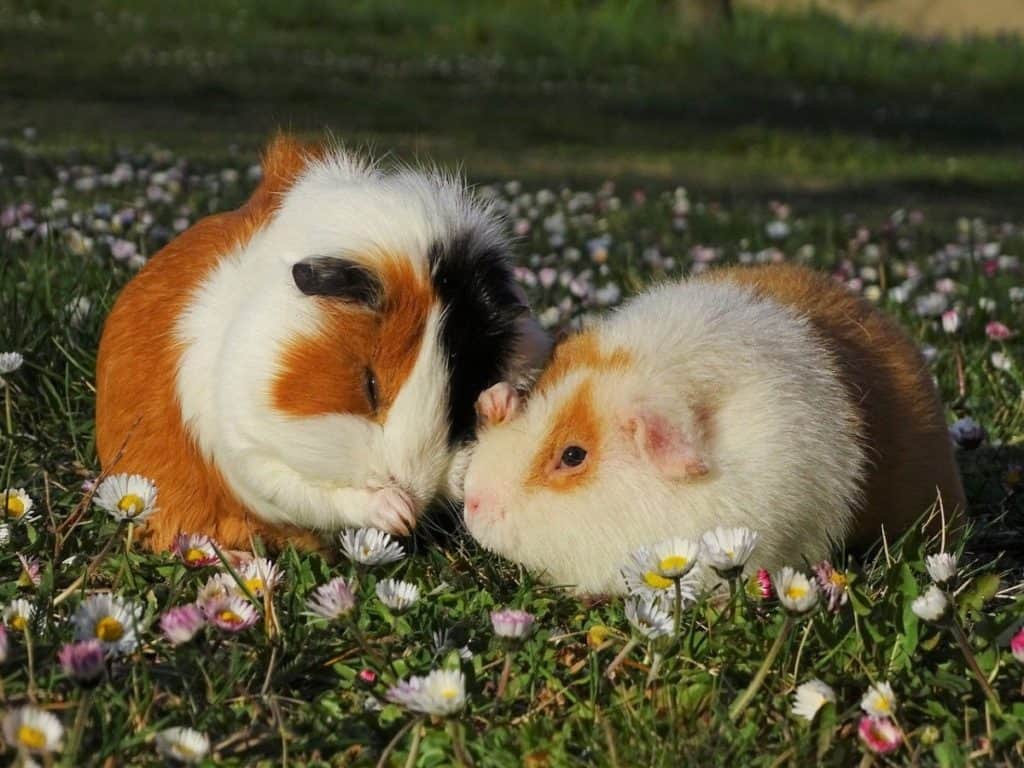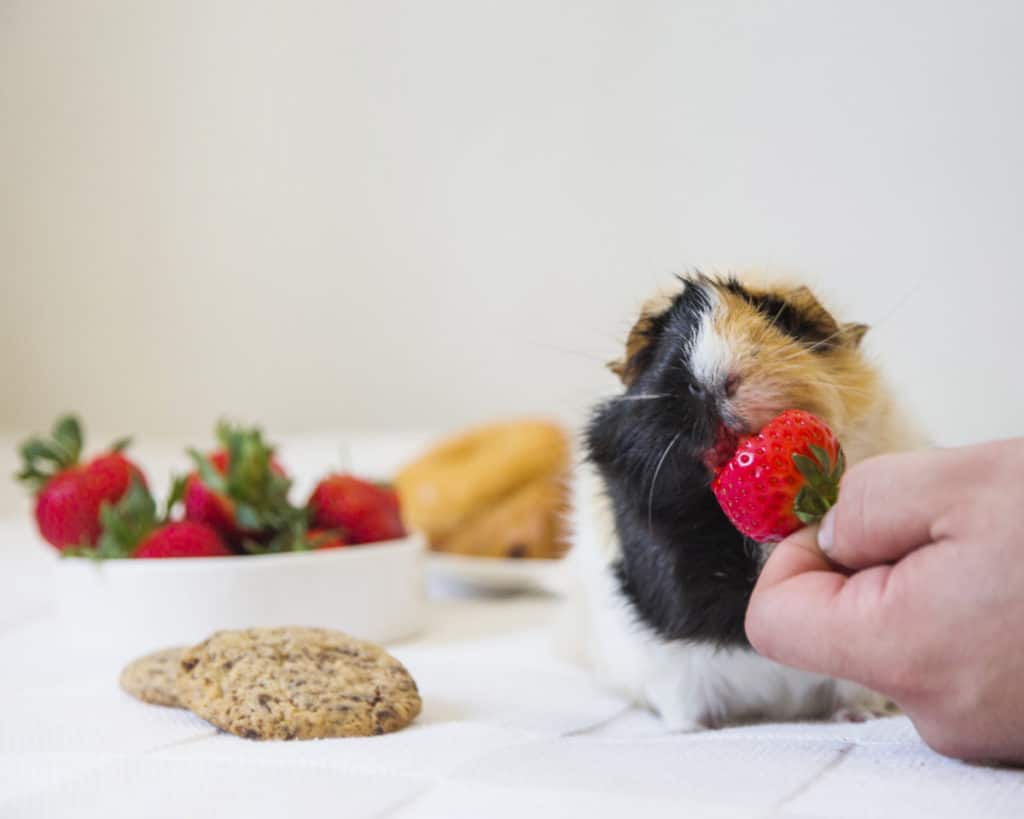Guinea Pig VS Hamster – What’s The Best Pet For Me?
Both guinea pigs and hamsters are very popular exotic pets, although they are quite different in many aspects. In the United States alone, the number of households keeping a hamster or a guinea pig is about the same, at about 1.5 million each. But is one easier to keep than the other?
In this article, we will compare the two species so that you have a better understanding of their differences and make an educated decision about which one you might want to consider as a pet.
9 Main Differences Between Guinea Pigs and Hamsters
| Guinea Pigs | Hamster | |
|---|---|---|
| Size | 8 – 19 inches | 6-8 inches (Syrian) / 2-4 inches (Dwarf) |
| Personality | Social | Solitary |
| Lifespan | 5 – 8 years | 2 – 4 years |
| Price | $10 – 40 USD | $10 – 20 USD |
| Activity | Diurnal | Nocturnal |
| Habitat | 1500 sq ft per pet | 450 sq ft per pet |
| Diet | herbivore | omnivore |
| Health Issue | Less Frequent | More Frequent |
| Geographical Origins | Peru, Chile | Europe, Asia |
1. Physical Differences: Guinea Pigs Are Much Larger Than Hamsters

Guinea Pigs
Physically guinea pigs are fairly different. First of all, guinea pigs are about 4 to 10 times the size of a hamster, depending on the breed. Guinea pigs can weigh anywhere from 1.5 to 4 pounds, while hamsters are typically between 1 and 4 ounces. Also, guinea pigs have large round heads and bodies, and they do not have tails.
Hamsters
Hamsters have features that are much more rodent-like. They tend to have tails, though they are fairly short on most hamster breeds (except for the Chinese hamster). They typically have round ears, short faces, and blunt noses. Hamsters also have fairly distinctive cheek pouches that they use to carry around food.
There are other physical differences between baby hamsters (called pups) and baby guinea pigs (called piglets). Hamster babies are born hairless and blind, while guinea pig babies are more fully-developed when firstborn with lots of hair.
2. Personalities and Temperament: Guinea Pigs Are More Social Than Hamsters

Guinea Pigs
Guinea pigs are very social animals. They are social with other guinea pigs, but they also like to socialize with humans. As far as socializing with each other, you might notice them playing with each other or even grooming each other. Guinea pigs are also very vocal. When awake, you will notice your guinea pig making a lot of different noises to communicate with each other. They will even purr if they are happy like cats do.
Hamsters
Hamsters are very active and curious creatures. Guinea pigs are also active, but not nearly as much as hamsters are. For this reason, you have to make sure your hamsters have plenty of ways to exercise and get their energy out. You are going to want a wheel of some sort and a climbing toy or two in the cage.
Another major difference between the personality of guinea pigs and the personality of hamsters is that hamsters are less social with each other. In fact, many hamsters will get very territorial and quite aggressive with each other if they are kept in the same cage. However, as long as hamsters are handled from a young age, they can do great socializing with humans.
3. Lifespan: Guinea Pigs Live Longer Than Hamsters
Guinea Pigs
Guinea pigs have significantly longer lifespans than hamsters. On average, guinea pigs live somewhere between 5 and 8 years. How long your guinea pig lives depends on a variety of different factors, some influenced by genetics and others influenced by care.
Hamsters
When considering the lifespan of your hamster, you have to consider the specific breed of hamster. For instance, Syrian hamsters have an average lifespan of about three years. Roborovsi hamsters tend to live a little longer, with an average lifespan of four years, while Chinese hamsters, Campbell hamsters, and Russian dwarf hamsters all typically live about two years.
4. Price: Hamsters Are Cheaper Than Guinea Pigs
Guinea Pigs
A guinea pig typically costs somewhere between 10 and 40 dollars. Additionally, because they are social animals, you are going to need to buy at least two. Many pet stores and breeders will not even sell you a solo guinea pig. Because of this, you can expect to pay between 20 and 80 dollars for a pair.
Hamsters
On the other hand, a hamster at a pet store will usually cost somewhere between 10 and 20 dollars. Additionally, since hamsters are happy on their own, you generally will not have to buy more than one. There are some breeders that specially breed hamsters with really good genetics and may sell them for significantly more.
5. Sleep: Hamsters Are Nocturnal, Guinea Pigs Are Diurnal
Guinea Pigs
Guinea pigs typically keep a similar sleep pattern as you. That means they tend to be most awake and active during the day. They are often the most active in the morning and evening, taking a nap during the middle of the day.
Hamsters
Hamsters are nocturnal. That means they usually sleep during the day and are most active at night. Because of this, you will want to interact with your hamster most in the evening, and if you keep your hamster in your room, the constant activity and noise through the night can be frustrating.
6. Habitat: Guinea Pigs Need More Roaming Space Than Hamsters
Guinea Pigs
Because guinea pigs are so much bigger than hamsters, they need a significantly larger cage. Experts generally recommend somewhere between 7.5 and 10.5 square feet per guinea pig. Additionally, the more guinea pigs that you have, the more cage space you need. Guinea pigs will also need bedding, a food bowl, a water bottle, and toys.
Hamsters

Hamsters, while smaller, still need a decent amount of space. For a singular hamster, you need about 450 square inches of space. If you are going to try to keep more than one hamster together (never Syrian hamsters), you should multiply the space by the number of hamsters. That means for two hamsters, you will need 900 square inches of space, and for 3, you will need 1350 square inches of space. Like guinea pigs, hamsters need bedding, a food bowl, a water bottle, hamster toys, and a wheel for exercise.
7. Diet: Guinea Pigs Are Hebivores, Hamsters Are Omnivores

Guinea Pigs
Guinea pigs are herbivores. That means their diet is made up of entirely plant foods. You can get some pellets to feed your guinea pig, or you can feed your guinea pig a mixture of hay, grass, and green vegetables. You will also notice that your guinea pig may eat his own droppings. This is actually good for them as it contains specific vitamins and nutrients that they need.
Hamsters
Hamsters are omnivores. That means that they eat both plants/vegetation and animal protein sources. You can use pellet food to give your hamster the nutrients that he needs, or you can make your own mix. The problem with a mix – whether you make it or buy it – is that hamsters will often pick through it and eat only their favorite pieces, causing them to miss out on lots of key nutrients.
8. Health Issues: Guinea Pigs Are More Resistant Than Hamsters
Guinea Pigs
Overall, guinea pigs are pretty easy to take care of and do not typically have any major health issues. However, they may develop a few different health problems, such as digestive tract problems and infections. If your guinea pig starts to show concerning symptoms, you should take him to your local vet.
Hamsters
Hamsters have a few more health issues that you should be on the lookout for. They are susceptible to digestive problems, skin diseases, teeth issues, respiratory infections, and tumors. Hamsters are also known to catch colds, just like humans. The good news is most of these conditions are entirely treatable, especially if caught early, so if you start to notice any symptoms, you should take your hamster to the vet immediately.
9. Geographical Differences: Guinea Pigs Are from The Andes, Hamsters Come From Asia and Europe
Guinea Pigs
Guinea pigs were originally wild animals native to South America. They were then domesticated as pets and were also used as food in many parts of the world. However, today there are no longer any guinea pigs in the wild, so you cannot just go out and catch one even if you are in South America.
Hamsters
Hamsters do still live in the wild. In fact, there are almost eighteen different wild hamster species, though, unfortunately, many of them are on the endangered list. You can find these different hamster species in many places across the globe. Wild hamsters can be found in China, Greece, Romania, Belgium, Syria, and other countries across Europe and Asia. However, you will not find any wild hamsters in North America, and they should not be released into the wild.

